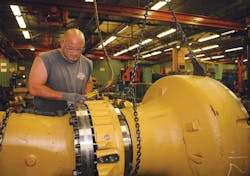Caterpillar: Using Proactive Leading Indicators to Create World-Class Safety
Traditional lagging safety metrics like OSHA recordable rates or lost-time case frequencies have been used for years to measure safety program success. At EHS Today America’s Safest Companies conference in Chicago earlier this month, Caterpillar Inc.’s Andy Schneider and Tim Crane discussed the company’s transition to a culture that utilizes leading indicators for safety.
According to Schneider, global manager for safety, health and EHS shared services, and Crane, manager of Caterpillar Safety Services, traditional metrics can help companies tell the score at the end of the game, but they don’t help employers understand the strengths and weaknesses of their safety efforts and cannot help managers predict future success.
In 2002, Caterpillar experienced over 20,000 injuries with 63,000 lost workdays, said Schneider. “A lot of customers were making the decision of who to do business with based on health and safety and we were not in good shape,” Schneider admitted.
In 2003, the company launched its Safety Strategic Improvement Process (SIP). The goal was to provide the leaders of the company with a process through which they could drive safety excellence. The critical elements of the Safty SIP included:
- Enterprise-wide statement of safety culture.
- Global process, tools and metrics.
- Top-down leadership of and engagement with the process.
- Clearly defined and linked roles and responsibilities.
- Clearly defined accountability.
- Consistent methods establishing targets and reporting performance.
- Consistent criteria for prioritizing issues and aligning resources.
- Recognition for positive behavior and performance.
Targets including driving down lost-time case frequency rates and recordable injury frequency rates. The process worked, creating an 85 percent improvement in the past 10 years, said Schneider. While lowering injury and lost-time numbers was the target, the program created another significant benefit:
Since it launched in 2003, the company has saved $450 million in direct and indirect costs related to decreases in injuries, illnesses and lost time. “We’re a big company, but that’s a lot of money for anybody. That’s the cost of being average,” said Schneider of the $450 million the company would have paid out if it had not adopted and successfully worked the Safety SIP.
He indicated the company has plateaued a little bit on its way to zero injuries, but added that safety again has been chosen for an SIP, this time with a focus on ergonomics that includes an ergonomic/safety assessment tool and integrated training and ergonomic requirements.
Crane asked the question that often is asked at Caterpillar: What makes a difference in safety? According to him:
- Level One is reacting. Often, companies at this level have 10 to 20 TRIR and 5 LTIR and have compliance programs, work orders, incident investigations and safety meetings.
- Level Two is “what we see” and companies have 3 to 9 TRIR with 1 LTIR. They rely on observation programs, job safety analysis, near-miss reporting and inspections.
- Level Three is “what we do” and companies have 1 to 2 TRIR and 0.1 LTIR and utilize safety accountability systems.
- Level Four was described by Crane as “what we believe, and this level has 0.5 to 0.9 TRIR and zero LTIR and features an “unseen cultural reality.”
- Level Five focuses on engagement and has 0.2 to 0.4 TRIR and zero LTIR. This level features effective, data-driven safety teams, said Crane.
- Level Six examines “how we lead,” said Crane, and has less than 0.2 TRIR and zero LTIR. This level is “Culture in action: participation, ownership, execution and live(ing) a passion for safety excellence.”
In order to create zero incident performance, the company uses a process that includes:
- Assessing the culture using one-on-one interviews and a safety perception survey.
- Building a plan by reporting and analyzing assessment results, training the safety steering team and agreeing on a strategic plan.
- Developing the process through safety culture excellence workshops, forming continuous improvement (CI) teams and coaching and leading CI teams.
- Implementing the process through pilot improvement projects and by implementing new processes.
- Checking the efficacy of the process by developing and utilizing an evaluation/feedback team. The process then goes back to the assessment aspect should changes be necessary for continuous improvement.
"Define, train, measure and recognize. Do it by involving safety leaders from all levels of the organization to pursue foundational safety processes, root cause incident resolution and accountabilities for every job,” said Crane. “We address safety the same way we address quality.”
About the Author

Sandy Smith
Sandy Smith is the former content director of EHS Today, and is currently the EHSQ content & community lead at Intelex Technologies Inc. She has written about occupational safety and health and environmental issues since 1990.
